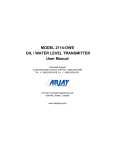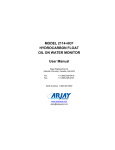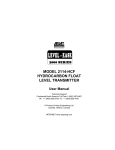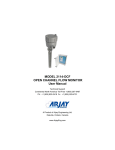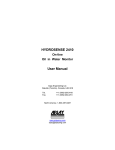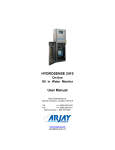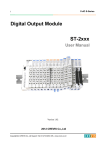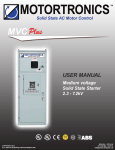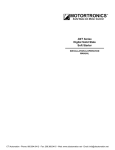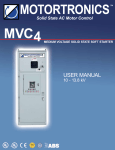Download 2114-OWM % Water In Oil Monitor User Manual
Transcript
2114-OWM % Water In Oil Monitor User Manual Technical Support Continental North America Toll Free 1-(800) 387-9487 Ph: +1 (905) 829-2418 Fx: +1 (905) 829-4701 A Product of Arjay Engineering Ltd. Oakville, Ontario, Canada www.ArjayEng.com Model: 2114-OWM 2114-OWM-UM Rev 1.2.doc Rev: 1.2 TABLE OF CONTENTS MANUAL DESCRIPTION ............................................................................................................ 3 1.0 INSTRUMENT OVERVIEW............................................................................................ 3 1.2 2.0 3.0 4.0 DESCRIPTION .................................................................................................. 3 INSTALLATION .............................................................................................................. 6 2.1 PROBES ............................................................................................................ 6 2.2 PROBE INSTALLATION ................................................................................... 6 2.3 ELECTRICAL INSTALLATION.......................................................................... 8 STARTUP AND CALIBRATION ..................................................................................... 9 3.1 NOTES ON VALUE ENTRY .............................................................................. 9 3.3 POWERUP DISPLAY ........................................................................................ 10 3.4 MINIMUM SETUP ............................................................................................. 10 3.4.1 XMTR VALUES................................................................................... 10 3.4.2 DATA FILTER (SMOOTHING) ........................................................... 10 3.4.3 ENGINEERING UNITS ....................................................................... 11 3.4.4 TAG NUMBER .................................................................................... 11 3.4.5 mA SETTINGS .................................................................................... 11 3.4.6 RELAY SETTINGS ............................................................................. 12 3.4.7 CALIBRATION .................................................................................... 13 3.4.8 FULL SCALE VALUE.......................................................................... 14 3.4.9 ENABLE ALARM RELAY CONTROL ................................................. 14 OPERATION .................................................................................................................. 16 4.1 DISPLAY MENU [DISP] .................................................................................... 16 4.2 CALIBRATION [CALIB] ..................................................................................... 16 4.3 4.4 4.2.1 AUTOMATIC CALIBRATION [CALIB\1] ............................................. 17 4.2.2 MANUAL CALIBRATION [CALIB\2] ................................................... 17 CONTROL MENU [CONT] ............................................................................... 17 4.3.1 mA SETTINGS .................................................................................... 17 4.3.2 RELAY SETTINGS ............................................................................. 18 4.3.3 RELAY SETTINGS SELECTION ........................................................ 18 4.3.4 RELAY SETTINGS EXAMPLES ......................................................... 19 SETUP MENU [SETUP] ................................................................................... 21 4.4.1 PMC 2000 (Manual) [SETUP \ 1 \ 2]................................................... 21 4.4.2 DIAGNOSTICS [SETUP \ 2] .............................................................. 21 4.4.3 SETTINGS MENU [SETUP \ 3] ......................................................... 21 5.0 TROUBLESHOOTING ................................................................................................... 23 6.0 CONTROLLER SETTINGS SHEET ............................................................................... 25 -2- Model: 2114-OWM 2114-OWM-UM Rev 1.2.doc Rev: 1.2 MANUAL DESCRIPTION This manual describes the features, installation, setup, and use of Arjay’s 2114-OWM series Oil/Water Monitor for tank profiling of oil/water emulsions and interfaces and % concentrations of water in oil in pipes and tanks. 1.0 INSTRUMENT OVERVIEW 1.1 FEATURES 1.2 Two to Five point Auto-Calibration for a Point to Point Calibration Curve Galvanically isolated probe input RF Technology Arjay pulse card system for simple, safe, remote control, calibration and maintenance 4 Differential Alarm relays (SPDT 8 Amp @ 120 VAC, 6.5 Amp @ 24 VDC, contacts) field adjustable Isolated mA output per probe Independently selectable as Direct / Inverse & 4-20 / 0-20mA output with offset capability RS-485 Modbus protocol No moving parts DESCRIPTION The unit senses the oil /water interface or emulsion concentration using a RF capacitance measurement technique for very high-resolution capacitance measurements. The probe capacitance to % concentration relationship is not linear over the full concentration range. Accuracies are best at or near the calibration points. The % indication and corresponding outputs are for trending and data collection only. Best sensitivity is provided in the Water in Oil phase. Lower sensitivity is provided in the Oil in Water phase. A probe mounted in the vessel forms a capacitor with the concentric shield or vessel wall. The active portion of the probe is the exposed Teflon coated portion of the probe end. In tank applications the upper portion of the probe is inactive using a stainless steel sheath to ignore upper dielectric changes and the vapour phase. In pipe applications, where the probe is continuously submerged in liquid, the inactive sheath is not required. The capacitance of this arrangement is directly proportional to the amount of water verses oil around the active portion of the probe. Multiple probes at various levels within a tank can be used to profile the oil/water concentrations at specific levels identified within the tank. This profiling is used to provide data for monitoring and control. A single probe in a pipe can be used to monitor for the phase change from oil to water or vice versa. Probe inputs and mA outputs are all galvanically isolated to minimize electrical interference. The Arjay Level-Ease 2000 Series system uses RF (Radio Frequency) methodology to measure the vessel capacitance. This technique minimizes the effects of other electrical properties of the probe, vessel, and vessel contents and focuses only on the liquid capacitance. The controller may be located up to one km away from an Arjay probe via inexpensive 2 wire shielded cable. The Arjay 2114-OWM series controller offers a 20 character by 4-line LCD and 16 key membrane keypad for detailed data display plus ease of calibration and setup. The Oil/Water reading is displayed in a percentage of Water and percentage of Oil. The raw probe capacitance in pF is also indicated. -3- 2114-OWM-UM Rev 1.2.doc Model: 2114-OWM Rev: 1.2 Figure 1.0 RS-485 Network (2 Wire) 2 Wire (shielded) Isolated input Intrinsic Safety Barrier (Optional) CAPACITANCE LEVEL PROBE Isolated 4-20mA Probes upto 1km away 220/115VAC or 24VDC 4 SPDT RELAY CONTACTS BLOCK2k.DRW OPERATION The unit senses concentration using a RF Capacitance measurement technique for very high-resolution measurements. A probe mounted in the vessel forms a capacitor with the concentric shield around the probe or vessel wall. The capacitance of this arrangement is directly proportional to the oil/water concentration in the tank and may be measured to provide signals and controls. USER INTERFACE Display Keypad Network 4 line X 20 Character LCD with backlight + bar graph. 4x4 Membrane type matrix. RS-485 / Modbus protocol PERFORMANCE Range Resolution Accuracy The unit measures capacitance in pF. Capacitance to concentration translation depends on the tank geometry and the type and temperature variance of the material being measured. The resolution figures for Capacitance are guaranteed. Percent Concentration Measurement figures are non-linear and for trending only. 0-1000pF recommended for the resolution figures listed below. 0-10,000pF may be measured with less resolution and accuracy. Capacitance: 0.03 % of Full Scale worst case. Typical: 0.01%. Level: 0.02% of Full Scale (6ft concentric shield probe in water) ±0.2% of Full Scale Note: This accuracy is in respect to the capacitance of the probe. This does not represent a % concentration accuracy of oil in water or an accuracy of an oil/water interface. Percent concentrations of oil/water emulsions and interfaces are not linear and can be affected by oil types, temperatures, chemicals within the system, etc. INPUTS 2 wire plus shield connection to an Arjay PMC-2000 module located in the Arjay Capacitance probe head. OUTPUTS / RELAYS mA output Relays 0.05% resolution, sourced into 900 Ohms maximum load. 4 SPDT 8A@120VAC, 6.5A@24VDC Each relay may be set for differential control (hi and low setpoints) Programmable time delay: 0 - 99 seconds. Hi Fail-safe selectable. -4- Model: 2114-OWM 2114-OWM-UM Rev 1.2.doc Rev: 1.2 POWER 24VDC @ 0.4A max. MECHANICAL SPECIFICATIONS Enclosure Wall Mount Type Nema 4X polycarbonate/Fiberglas enclosure. Dimensions Mount Nema 4X: 14” x 12” x 7” Weight 6kg (13lbs) wall mount enclosure only ENVIRONMENTAL SPECIFICATIONS Operating Temp. 0 to 60 Deg. C for Controller only. Probe Head: -40 to 80 Deg. C, wetted probe: -40 to 250 C Relative Humidity 90% max. with no condensation. -5- Model: 2114-OWM 2.0 2114-OWM-UM Rev 1.2.doc Rev: 1.2 INSTALLATION NOTE: If any damage to the instrument is found, please notify an Arjay Engineering representative as soon as possible prior to installation. 2.1 PROBES Capacitance probes may be selected from a variety of styles for liquid interfaces. The probe length is customer specified for the application. Usually Teflon coated probes are used. 2.2 PROBE INSTALLATION A basic pipe installation will include a Capacitance probe only. Tank applications may include any of the following accessories. 1. Capacitance Probe. This includes a sheathed or unsheathed length of probe. The probe length is determined for the tank or pipe it is being used on. If installed into a pipe, a preferred location will be at an elbow where a TEE can be installed to insert the probe into the downstream flow. In tank applications, the length will be determined by the insertion length necessary from the tank fitting to the point of desired measurement. 2. Concentric Shield. This is permanently installed into the tank and consists of a SS tube with slits to allow free flow of fluids. This forms a linear ground reference and physical stabilizing guide for the capacitance probe. 3. Retraction Assembly. This is a sealed unit that can be loosened to allow retraction/insertion of the probe during process operating conditions. This allows easy and quick calibration, manual profiling of the capacitance values within the tank, and placement of the probe at its determined level for permanent profiling. 4. Spool/Isolation Valve/Blowdown Assembly. This allows retraction of the probe completely from the vessel under process conditions. The probe is retracted until the active portion is within the spool. The isolation valve may then be closed; the blow down valve is then relieved. The probe assembly may then be removed from above the spool assembly 5. Safety Chain. A safety chain helps to prevent removal of the probe without following proper procedures. The short chain section can be removed to allow retraction to within the spool piece. The longer chain length helps to prevent complete removal of the probe. The probe guide welded to the probe also restricts the probe from being removed from the retraction device. -6- 2114-OWM-UM Rev 1.2.doc Model: 2114-OWM THREADED ENTRY FLANGED ENTRY Rev: 1.2 CONCENTRIC SHIELD ENTRY Use wrench on Lower Hex ONLY 2" Entry Typical 1- For threaded and flanged entry types, the probe must be parallel to the tank wall 2- For threaded and flanged entry types, measurement sensitivity is increased by reducing the probe to wall distance. 3- There should be good electrical conductivity between the tank wall and the transmitter enclosure. (For probes with a concentric shield this is not important). INSTALL PROBE WITH CARE: IF TEFLON COATING IS DAMAGED, THE PROBE WILL NOT WORK PROBE HEAD TOP VIEW WITH COVER REMOVED 1- Remove probe cover 2- If PMC-2000 is not already installed, bolt it into the standoffs in the base of the probe enclosure. The orange connector should face away from the probe. 3- Remove the mating connector and wire it as shown. The shield SHOULD NOT BE CONNECTED. Plug the connector back. PROBE TIP WITH PROBE WIRE TO THE PMC-2000 MATING CONN. + SHLD (NOT CONNECTED THIS END) 4- IMPORTANT! the enclosure MUST BE EARTH GNDED. Either via tank if it is connected to earth gnd or via a separate gnd connection to the GROUND LUG. PROBE2K.DSF GND LUG PROBE INSTALLATION Figure 2.0 -7- PMC-2000 MODULE 2114-OWM-UM Rev 1.2.doc Model: 2114-OWM Rev: 1.2 2.3 ELECTRICAL INSTALLATION All connections are via plug-in connectors for installation convenience. #2 + - #1 + - #2 + - #1 mA OUTPUTS Isolated mA sourced outputs - NOT loop powered! + - PROBE CONNECTION To PMC-2000 card in each Arjay level probe head. + + + - PROBES CAT I mA OUTS + + + 24VDC power for DC powered models + - ! The network connection is optional for 2200 series and standard for the 2400 series models, and requires an Arjay Central Access Panel (CAP) or Handheld Calibrator for data access. NET 24V SEE USERMANUAL The 24VDC is the power input for DC powered models. For AC powered models, the power connection is on the bottom of the unit. Caution: to reduce the risk of fire or electric shock, do not interconnect the outputs of different terminals. Shield connected to Earth Gnd at 2xxx controller only - not connected at PMC-2000 + Optional RS-485 Network connection Connect to Earth Gnd. for DC powered models 250V, T160mA AVAILABLE RELAYS: Model Relays available 2xx0 None 2xx2 Relay 1 & 2 2xx4 Relay 1 - 4 POWER L N RELAY3 RELAY4 RELAY1 RELAY2 G( ) See Drawing 20050164 Installation for Protective Earth Ground on Subplate Ground Strap to Enclosure lug AC POWER 120VAC 230VAC Elecinst2k3.dsf L N G L1 L2 G ELECTRICAL CONNECTIONS Figure 2.2 -8- ! PLEASE OBSERVE CONNECTION POLARITY AS SHOWN OR DAMAGE MAY RESULT. 2114-OWM-UM Rev 1.2.doc Model: 2114-OWM 3.0 Rev: 1.2 STARTUP AND CALIBRATION This Section is provided for minimum setup. For a more detailed description of features please refer to Section 4.0. RELAY LEDS: ON = HI ACTING ALARM R1 4 line x 20 char LCD R2 R3 STATUS LED: GRN = OK RED = ERROR R4 STATUS DISPLAY 1 2 3 CAL 4 5 6 CONTROL 7 8 9 . 0 ENTER SETUP www.arjayeng.com DISPLAY CALIB CONTROL SETUP DISPLAY KEY: Displays Level Information. Also used as backspace in value entry. CALIBRATE KEY: For probe calibration menus. CONTROL KEY: For 4-20mA output and Alarm Relay settings. SETUP KEY: For configuration and diagnostics. USRINT2k.dsf 3.1 Membrane keypad USER INTERFACE Figure 3.0 NOTES ON VALUE ENTRY When entering in numeric values, the cursor can be backspaced to correct mistakes by pressing the DISPLAY key. This is only true if the cursor is not at the beginning of the displayed value, in which case the DISPLAY menu is entered. Values may be entered with any number of places of decimal. If the entered value is out of the allowed limits, the system displays the limiting value for 2 seconds. For example if the mA Span value is entered as 5000.0% then MAX. 100 is displayed for 2 seconds then entry is allowed again. The current value is not changed unless the entered value is within limits. During value entry, the capacitance and concentration are still being constantly updated in the background. Apart from the CALIBRATION menu and the DIAGNOSTICS menu, in all other menus, the Alarm relays and the mA output are also updated. -9- Model: 2114-OWM 3.3 2114-OWM-UM Rev 1.2.doc Rev: 1.2 POWERUP DISPLAY After mechanical and electrical installation of the probe and the controller has been successfully completed, power up the unit. A similar startup screen will be displayed for about 3 seconds: Arjay Engineering Level-Ease 2114 OWM Rev: 3.00 / 2057_28 S/N: 001234 The Rev. line displays the Hardware Revision followed by the Software Revision separated with a “/”. The Serial Number is displayed by itself on the bottom line. After the startup screen, the LCD should show a screen similar to: Oil / Water Monitor 90.0 % Water 10.0 % Oil 343.53 pF NOTE: The shown values are for example only. The Status Indicator (see figure 3.0) should be green. If this is red then the LCD displays the kind of System Error. See the troubleshooting guide for details. 3.4 MINIMUM SETUP 3.4.1 XMTR VALUES These are factory preset but should be confirmed once installed. Press the SETUP key, then 1 for PMC 2000, then 2 for Manual. This menu enters the PMC-2000 level transmitter module’s calibration parameters. These parameters are printed on a label attached to the PMC-2000 card in the probe head. These values should also be noted down in the SETTINGS table located at the end of this manual. On pressing 2 for Manual: ** PMC 2000 SETUP ** Enter xmtr A value: 0.03316 Enter the PMC-2000 module A value then press Enter. The unit will prompt for the K and C values. Enter these followed by pressing the Enter key in each case. 3.4.2 DATA FILTER (SMOOTHING) Press the SETUP KEY, then press 3 for Settings, then 1 for Filter. ******SETTINGS****** Enter filter time in seconds: 0.0 Enter the data response time in seconds for the unit to respond to a sudden change followed by the Enter key. For example a 5 second setting means the calculated value of the vessel capacitance and resulting values of concentration in % will take 5 seconds to respond to an actual sudden change in vessel level. 3.4.3 ENGINEERING UNITS The display engineering units of % and pF are preset on this model. 3.4.4 NETWORK TAG NUMBER THE TAG NO.s ARE USED ONLY FOR NETWORK APPLICATIONS AND ARE USUALLY FACTORY SET. To communicate on a network, each controller must have a unique Tag Number (also called node address). -10- Model: 2114-OWM 2114-OWM-UM Rev 1.2.doc Rev: 1.2 Important: if multiple units on a network have the same address, network errors will result. An Arjay Central Access Panel (CAP) is required to communicate with 2000 series level controllers on a network. The CAP allows data to be viewed from and remote calibration / set of any 2000 series level controller on the network from a central location. Press the SETUP KEY if not already in the Setup menu, then press 3 for Settings, then 2 for Tag #. Enter the desired tag number. 3.4.5 mA SETTINGS The mA output can reflect 0% to 100% water in oil content or can be offset within this range. Press the CONTROL key: **CONTROL SETTINGS** 1-Relay Settings 2-mA Settings Press 2 to setup the mA output: ***SET mA OUT*** Zero (% Water) 0.0 Span (% Water) 100.0 Enter the desired % Water for Zero (4 mA) and % Water for Span (20 mA) values followed by the Enter key in each case. After the Enter key is pressed for the Span value, the following menu is displayed for additional mA settings: ***SET mA OUT*** Action: Direct Type: 4-20mA The cursor will be on the Action setting line. Pressing 1 toggles between Direct and Inverse action. Direct action causes the 4mA to be output when the level is at the Zero setting and 20mA to be output when the level is at the Span setting. Inverse action is the reverse of Direct action. Press the ENTER key when done. The cursor now drops to the Type setting line. Pressing 1 toggles between 4-20mA and 020mA. The 0-20mA as the name implies, outputs a signal between 0-20mA instead of 420mA. The 0-20mA setting generally offers a little better measurement resolution. 3.4.6 RELAY SETTINGS For help in selecting the relay settings please refer to Sections 4.3.2 - 4.3.4. Press the CONTROL key, then press 1 for Relay Settings: ** RELAY SETTINGS ** 1-Relay1 2-Relay2 3-Relay3 4-Relay4 5-Disable Alrms (ENA) Disable relays. Pressing 5 toggles between Enabling (ENA) and Disabling (DIS) alarms. The current state is displayed on the right extreme of the bottom line of the LCD. A Disable setting will disable Alarm relay alarms even if an Alarm condition exists. The factory default setting is ON (ENA) which allows Alarm relays activation. Relays can be enabled AFTER calibration and setup are complete. -11- 2114-OWM-UM Rev 1.2.doc Model: 2114-OWM Rev: 1.2 Press 1 to setup Relay1 (of 4): * RELAY 1 SETTINGS * Action: HI (1 for LO) Flsafe: OFF(1 for ON) Next select the Alarm Action by pressing 1 to toggle between High and Low action. See Section 4.3.2 – 4.3.4 for help in selecting this value. Press ENTER after selecting Action. Next select the Failsafe type by pressing 1 to toggle between On and Off. See Section 4.3.2 – 4.3.4 for help in selecting this value. Press ENTER after selecting the Failsafe type. After selecting the Failsafe setting the following menu is displayed: * RELAY 1 SETTINGS * Hiset (%water) 20.00 Loset (%water) 15.00 On Delay (sec): 0 Enter the High and Low alarm (Hiset and Loset) values in percent level. Press Enter after each entry. If Differential control is not desired then set the High and Low alarms to the same value. Finally, set the ON delay in seconds. This is how long an alarm condition must exist before the corresponding relay is switched to an alarm condition. The following table shows the effect of the Relay Action and Failsafe settings. See also Sections 4.3.2 – 4.3.4 for further details. Relay Action Failsafe Setting Effect High No Alarm condition when process level rises above the High Setpoint for at least the alarm delay period. Alarm condition remains active until the process level drops below the Low Setpoint. No action is taken when the process level is between the High and Low Setpoints. In the alarm condition, the corresponding alarm LED is turned ON, and the relay is energized. High Yes Alarm condition set and reset as above. In the alarm condition, the corresponding alarm LED is turned ON, but the relay is de-energized. Low No Alarm condition when process level drops below the Low Setpoint for at least the alarm delay period. Alarm condition remains active until the process level rises above the High Setpoint. No action is taken when the process level is between the High and Low Setpoints. In the alarm condition, the corresponding alarm LED is turned ON, and the relay is energized. Low Yes Alarm condition set and reset as above. In the alarm condition, the corresponding alarm LED is turned ON, but the relay is de-energized. -12- Model: 2114-OWM 2114-OWM-UM Rev 1.2.doc Rev: 1.2 The Relay Settings menu is now displayed from which other relays may be selected to be set up. Set the remaining relays 2 – 4 in the same way. 3.4.7 CALIBRATION The calibration requires a minimum of two % water readings to be entered in to controller keypad. The most convenient form of calibration is the Auto Cal feature. For the most reliable data output the calibration should be done under operating conditions and will require the tank to contain both 100% water and 0% water (100% oil) conditions, if the full 0—100% range is being used. Up to five % concentration points can be entered. Any number of entries from two to five are accepted. The controller will internally calculate a point to point curve between the number of points entered. A minimum of two points are required. Press the CALIBRATION key *** CALIBRATION **** 1-Auto CAL 2-Manual CAL Press 1 *** MULTIPOINT AUTO CAL**** Enter = Do cal point 1 0 = Calibration Done The display will prompt you to Do Cal Point 1. Press Enter to accept. Lower the probe (if retraction option supplied) or fill the pipe or tank until the active portion of the probe is fully immersed in water. Enter the value of 100.0%. The probe capacitance (raw signal) displayed on the bottom line of the LCD is for observation and may be used to confirm that the product in the tank is stable. Press ENTER. The unit now prompts for the 2nd concentration of water. Raise the probe (if retraction option supplied) until the active portion is fully immersed in oil or change the pipe or tank liquid to oil. Enter the value of 0.0%. Again, the tank capacitance is displayed on the bottom line of the LCD to observe stability. Press ENTER. The unit now prompts for the 3rd concentration. If other concentration entries are available follow the procedure as above. If not, Press 0 to exit. If the calibration was not successful, an error message is flashed on the screen for 2 seconds. Common problems are either the concentration was not changed or that the 2nd level value in % was entered identical to the 1st. At the end of a calibration, the unit calculates the slopes between the points entered. If 100% or 0% were not entered as one of the points, the controller will extrapolate the slope next to it to reach the 0% or 100%. The slope is the amount of capacitance change per percent concentration change (sensitivity). This completes the calibration. For more calibration details, see Section 4.2. 3.4.8 FULL SCALE VALUE This is automatically determined as a 100% value for this application. 3.4.9 ENABLE ALARM RELAY CONTROL If the Alarm Relays are being used, now that calibration has been successfully completed, the Alarm Relay control may be re-enabled. Press the CONTROL key to get to the CONTROL menu, then 1 for Relay Settings then 5 to Enable. -13- Model: 2114-OWM 2114-OWM-UM Rev 1.2.doc The right, bottom corner of the display should show ENA for enabled. Press the DISPLAY key to go back to the Display menu. THIS COMPLETES THE SETUP AND CALIBRATION PROCEDURE NO FURTHER SETUP OR CONFIGURATION IS REQUIRED THE NEXT SECTION (4) IS FOR REFERENCE ONLY -14- Rev: 1.2 Model: 2114-OWM 4.0 2114-OWM-UM Rev 1.2.doc Rev: 1.2 OPERATION IN THE FOLLOWING TEXT A MENU WILL BE DISPLAYED AS A PATH. FOR EXAMPLE THE AUTOCAL MENU: [CALIB\ 1]. (CALIB key then 1 for AUTOCAL). SETTINGS MENU: [SETUP\3] (SETUP key then 3 for SETTINGS). The 2000 series Monitor uses a high precision and highly repeatable RF technique to measure capacitance, which in turn is used to calculate concentration. The capacitor is formed by the level probe (mounted vertically into the vessel) and the ground reference or shield. The capacitance is directly proportional to the dielectric constant of the material in the vessel. The dielectric constant is a physical property of matter and is different for different materials. Water has a dielectric constant of about 80 as compared to 2.5 for most oils. Therefore, water gives a much higher change in capacitance than oils which makes measuring the level of water much more precise as compared to oils. Arjay’s method of measuring capacitance gives better than 0.1pF resolution for typical applications. All Level-Ease 2000 Series Controllers and Transmitters are intelligent and can perform a number of tasks simultaneously (multitasking software). This means that even while in another menu, the capacitance is always being measured in the background. For example if the Filter value is being set in the SETTINGS submenu (SETUP\SETTINGS menu), the level value, relay alarms and mA outputs are still being updated. This is important since keypad entries are typically slow and sometimes an operator might forget to return the unit to the normal DISPLAY menu: in this case Alarm relays and mA output are still updated. In some menus however, the mA output and or the Alarm Relays are not updated on purpose; for example while in the calibration menu, the unit assumes that the unit is being calibrated and so the calculated level may be erroneous. In this case, the mA and Alarm Relays are set to the inactive states. Periodically, (every 5-10 seconds) the unit does a self-diagnostic. If major errors are found they are displayed on the LCD. These error messages take precedence over the level information in the DISPLAY menu ONLY. All other menus may be entered and parameters viewed or changed. In case of errors, this allows the user to enter the DIAGNOSTICS menu and check the capacitance or frequency etc. 4.1 DISPLAY MENU [DISP] This is the default or normal operating screen. It shows: Oil / Water Monitor Water: 62 % Oil: 38% PF: 141.1 4.2 CALIBRATION [CALIB] The unit may be calibrated 2 different ways: Automatic Calibration and Manual Calibration. Pressing the CALIBRATION key enters the CALIBRATION menu: *** CALIBRATION **** 1-Auto CAL 2-Manual CAL 4.2.1 AUTOMATIC CALIBRATION [CALIB\1] This is typically done for a new installation. It involves entering the independently and ACCURATELY MEASURED % concentration in the vessel, changing the concentration by some amount, and then entering the new ACCURATELY MEASURED %. Up to 5 points are entry may be made to install a point to point calibration curve for the application. -15- Model: 2114-OWM 2114-OWM-UM Rev 1.2.doc Rev: 1.2 NOTE: The accuracy of the calibration depends in large part on the accuracy of the measured concentrations entered during calibration. The resolution of measurement should be 2 decimal places to get the best accuracy. This is also why a minimum of 10% change in level is recommended for the 2 calibration points, since the larger the difference, the less affect the inaccuracies of entered levels has on the calibration. For example, a 1% error in entered values over a 10% change translates to a 10% error at Full Scale (100%). 4.2.2 MANUAL CALIBRATION [CALIB\2] This option is used to fine-tune the values after a successful Automatic Calibration or when % vs pF values are already known. For example if the capacitance and corresponding concentrations in % have been recorded over some time then these can be used to recalibrate the unit. The procedure is as follows: At any time, to view the measured capacitance: Press the SETUP key then 2 for Diags: Read the capacitance in pF on the 2nd line from the top. Determine the actual percent water concentration in the vessel: (2 places of decimal accuracy) TO CALIBRATE USING MANUAL CALIBRATION: Press the CALIBRATION key to get to the CALIBRATION menu then 2 for Manual. Scroll through the values by pressing ENTER until the values to be changed are displayed. Enter the new values and press ENTER 4.3 CONTROL MENU [CONT] The CONTROL menu allows the setup of the mA output and the Control Relays. NOTE: The Control Relays and the mA output are set to their OFF states when in the CALIBRATION menu [CALIB]. In the DIAGNOSTICS menu [FUNCTION \ 2], the mA output may be set manually by the operator to 4mA or 20mA. In this case the mA output does not reflect the concentration value. 4.3.1 mA SETTINGS The mA output Zero and Span settings may be set anywhere within the measurement range. For example, if the Zero is set to 30% water and the Span is set at 60% water then the mA output is scaled between these two points with the mA output indicating low level at 30% and high level at 60%. NOTE: the Span value (% water) must be at least 1% greater than the Zero value. The mA output may also be set to Direct or Inverse Acting. In Direct Action, the mA output is 4mA when the level is at the Zero level and 20mA when at the Span level. In Inverse Action, the mA output is 20mA when the level is at the Zero level and 4mA when at the Span level. 4.3.2 RELAY SETTINGS Arjay Level controllers may be used to control devices such as pumps, valves and other equipment based on % concentration values. Arjay controllers allow 5 parameters: 1. HIGH ALARM (or CONTROL) POINT. This value is specified in % water. Above this value, relay action is taken depending on the Relay Action and Failsafe settings. 2. LOW ALARM (or CONTROL) POINT. This value should be less than the High control point. Below this value, relay action is taken depending on the Relay Action and Failsafe settings. 3. RELAY ACTION . High or Low Action. Selecting high action will energize the relay when the level exceeds the high control point for at least the time delay period. An LED on the front panel -16- 2114-OWM-UM Rev 1.2.doc Model: 2114-OWM Rev: 1.2 for the appropriate relay indicates the alarm condition. The relay is de-energized (with no delay) when the level falls below the low control point. Selecting low action will energize the relay when the level falls below the low control point for at least the time delay period. The relay is deenergized (with no delay) when the level rises above the high control point. 4. FAILSAFE. Failsafe typically means that the relay is normally (when not in an alarm condition) held in an energized state. In an alarm condition, the relay is de-energized i.e. identical to when the instrument power is shut off. The rationale is that the alarm condition should match the Power Fail condition. 5. RELAY DELAY. Minimum time in seconds for an alarm to exist before the corresponding relay is set to its alarm state. The relay alarm state depends on the Relay Action and Failsafe settings. 4.3.3 RELAY SETTINGS SELECTION 1. Identify the positive action required in the control application such as turning on a pump, opening a valve, or sounding an alarm. Note: the time delay is applied to the start of the positive action; also, the corresponding LED is turned on to indicate the positive action. 2. Identify if Fail Safe condition is required in an alarm condition. For control applications (relay used to control pump etc.), the positive action may also be viewed as the opposite state desired in the event of a power or instrument failure. For alarm applications (relay used to indicate an abnormal condition such as a high tank level), the positive action may be the same state desired in the event of a power or instrument failure. 3. Identify the type of relay action required: if the positive action is required when the level exceeds the high control point then select High Action for the relay. If the positive action is required when the level falls below the low control point then select Low Action. 4. Identify the relay contacts to use (either Normally Open or Normally Closed). The contacts used are dictated by the failsafe setting and if the positive action requires the application of power or removal of power to the controlled device. The following table summarizes the settings for all possible requirements: # DESIRED CONTACT CONDITIONS DO THIS BELOW ABOVE INSTRUM. Or FAILSAFE RELAY USE LOW SETPOINT HIGH SETPOINT PWR FAILURE SETTING ACTION CONTACTS 1 Open Closed (PA) Open No High Acting NO 2 Open Closed (PA) Closed Yes High Acting NC 3 Closed (PA) Open Open No Low Acting NO 4 Closed (PA) Open Closed Yes Low Acting NC 5 Open (PA) Closed Closed No Low Acting NO 6 Open (PA) Closed Open Yes Low Acting NC 7 Closed Open (PA) Closed No High Acting NO 8 Closed Open (PA) Open Yes High Acting NC (PA) = positive action desired such as turning on a pump. -17- Model: 2114-OWM 2114-OWM-UM Rev 1.2.doc Rev: 1.2 Conditions 1, 3, 5, 7 are typically for control applications where the positive action i.e. turning on a pump, should be shut off during a power failure to the Arjay level controller. Conditions 2, 4, 6, 8 are typically for alarm applications where the positive action i.e. sounding an alarm if the level is at a high level, should also be in place during a power failure to the Arjay level controller. 4.3.4 RELAY SETTINGS EXAMPLES 1- A Pump is desired to be turned on when the concentration exceeds 30% and then turned off when the concentration drops below 20%. In the event of the Arjay unit failing or a power failure, the pump should be shut off to prevent if from pumping dry. Settings: High control point: 30% Low control point: 20% Failsafe: No Relay action: High acting Contacts used: Normally Open Explanation: In this case the positive action is turning on a pump. Since the pump should be turned off if the Arjay unit fails or in the event of a power failure i.e. the positive action state is not the same as the failure state, the failsafe setting should be No. Since the positive action is desired when the level exceeds the high control point then the relay setting should be High Acting. Since the pump starter requires power to turn on the pump and the failsafe is No, the normally open contacts should be used. The time delay may be set to some convenient value to minimize relay chatter. Even with no time delay, relay chattering due to the level fluctuating around the high control point is in this case not a problem since the once the relay is energized, it is not de-energized until the level drops below the 20% level. 2- An alarm buzzer and light must be turned on if the concentration in a tank exceeds 30% or in the event of an instrument or power failure. Settings: High control point: 30% Low control point: 30% Failsafe: Yes Relay action: High acting Contacts used: Normally Closed Explanation: In this case the positive action is turning on a buzzer and light. Since the buzzer / light should also be turned on if the Arjay unit fails or in the event of a power failure i.e. the positive action state is the same as the failure state, the failsafe setting should be Yes. -18- Model: 2114-OWM 2114-OWM-UM Rev 1.2.doc Rev: 1.2 Since the positive action is desired when the level rises above the high control point, the relay setting should be High Acting. Since the buzzer / light require power to turn on, and the failsafe setting is Yes, the normally closed contacts should be used. The High and Low control points are set to be identical. The low point can be set a little lower i.e. 28% to provide some dead band. In an alarm application, the alarm time delay should be set as low as possible. 4.4 SETUP MENU [SETUP] The SETUP menu is used for one-time setup and for Diagnostics. ********SETUP******** 1-PMC 2000 2-Diags 3-Settings 4.4.1 PMC 2000 (Manual) [SETUP \ 1 \ 2] This menu is to calibrate the 2000 series controller for the particular PMC-2000 level transmitter module located at the probe head. There are 3 calibration parameters: A, K, C. These values are used to calculate the capacitance from the frequency signal received from the PMC-2000. The parameters may be calibrated manually or automatically. Automatic Calibration is performed at the factory on each PMC-2000 module. A label listing the A, K, C values is then affixed to the PMC-2000 connector. AUTOMATIC CALIBRATION IS ONLY TO BE PERFORMED BY AUTHORIZED PERSONNEL AND IS BEYOND THE SCOPE OF THIS MANUAL. IF PROBLEMS ARE ENCOUNTERED, OR IF THE A, K, C VALUES ARE NOT KNOWN, PLEASE CONTACT AN ARJAY REPRESENTATIVE. Manual entry of the A, K, and C values is described in Section 3.4.1 4.4.2 DIAGNOSTICS [SETUP \ 2] This menu displays the received frequency signal from the PMC-2000 module at the probe head and the calculated capacitance. Both of these values are useful in determining calibration or performance problems. ****DIAGNOSTICS***** 12.04pF 4461.48Hz 1-4mA 2-20mA 3-Other Pressing key 1 forces the mA output to 4mA. Similarly pressing key 2 forces the mA output to 20mA. Any other value between 0 and 20 may be set by pressing 3 for “Other” then entering the desired mA output value. This feature is convenient to check the performance of external recorders or PLC’s, which read the mA output. The mA output reverts back to its actual level when the normal Display Menu is selected. 4.4.3 SETTINGS MENU [SETUP \ 3] This menu sets the digital filter and the engineering units. In addition the mA output may be trimmed for maximum accuracy. Also the Tag number and Software revision may be viewed: ****** SETTINGS ****** 1-Filter 2-tag # 3-mA Trim 2112 Rev:2057_28 mA TRIM: -19- Model: 2114-OWM 2114-OWM-UM Rev 1.2.doc Rev: 1.2 This procedure trims the mA output for maximum accuracy by compensating for the mA output circuitry tolerances. THIS PROCEDURE IS PERFORMED ON EVERY TRANSMITTER AT THE FACTORY AND IS TO BE PERFORMED BY AUTHORIZED PERSONNEL ONLY. IF IMPROPERLY DONE, THE ACCURACY OF THE mA OUTPUT IS AFFECTED. Under certain conditions this procedure may be undertaken in the field with Arjay’s permission: Press the SETUP key, then 3 for Settings and then 4 for mA Trim. The unit will put out what it thinks is 20.0mA. Disconnect any load connected to the mA output of the transmitter. With an ACCURATE MULTIMETER MEASURE THE mA OUTPUT. The Multimeter should have at least one place of decimal. Enter this value at the prompt and press the Enter key. A maximum tolerance adjustment of 3% is allowed i.e. the entered value must be in the range of 19.4mA to 20.6mA. If a value out of this range is entered an error is flashed on the screen. If this occurs, contact an Arjay representative for assistance. FILTER, ENGINEERING UNITS, TAG #: These settings are described in Section 3.4.2, 3.4.3, and 3.4.4 respectively. -20- Model: 2114-OWM 5.0 2114-OWM-UM Rev 1.2.doc Rev: 1.2 TROUBLESHOOTING CONDITION DO THIS 1. DISPLAY MENU SHOWS: The unit is not receiving a frequency signal from the remote PMC-2000 level transmitter in the probe head: Check wiring. Error: No Xmtr Signal If wiring checks out: call Arjay Technical Support. An adjustment may be made at the controller. 2. DISPLAY MENU SHOWS: Error: Setup Values Bad This indicates that one of the calibration or setup parameters has been corrupted. Compare ALL parameters with the table in Section 6 to find out which one. Re-enter it. Call Arjay Technical Support 3. DISPLAY MENU SHOWS: Error: pF out of range The calculated capacitance is out of the legal range: Check if the A,K,C values in the unit correspond to the A,K,C values of the PMC-2000 transmitter. Check the integrity of the Teflon sheath of the probe. If this has been damaged, water could cause an electrical short circuit between the probe within the Teflon sheath and the ground reference. In this case a very high capacitance is usually registered. Check the Xmtr frequency in the Diagnostics menu. If the frequency is much below 19,000Hz then a short circuit should be suspected. To confirm: Open the probe head and disconnect the blue wire from the probe to the PMC-2000. Using a DVM, measure the resistance between the enclosure case and the probe tip. It should read infinite resistance or OL. Make sure that fingers and hands do not touch the metal portion of the probes of the DVM since this could show a lower resistance: 1-10mohms. Contact an Arjay Representative. 4. The % reading is erratic or unstable Check if the probe is being splashed by incoming liquid or if there are moving mixer parts (especially metallic) close to the probe. If this is true, then try increasing the Filter time setting. If this is not enough, and the cause of the disturbance cannot be rectified then a concentrically shielded probe must be used. 5. Readings are not accurate i.e. the displayed values are not accurate as the level moves away from the calibration points. For probes without a factory supplied concentric shield, make sure the probe is parallel to its ground reference, which may be the tank wall or the inside of a stilling pipe (if probe is installed in a pipe). See Probe Installation SECTION 2.2 for more details. For probes with a factory supplied concentric shield, make sure the pressure equalizing slots / holes in the shield are unobstructed i.e. the liquid level inside and outside the shield are always the same. -21- Model: 2114-OWM 6.0 2114-OWM-UM Rev 1.2.doc Rev: 1.2 CONTROLLER SETTINGS SHEET Checked by Model Number Serial Number Software Rev. PARAMETER DESCRIPTION FACTORY USER SETTING SETTING Probe A value Probe PMC-2000 level transmitter calibration value Probe K value Probe PMC-2000 level transmitter calibration value Probe C value Probe PMC-2000 level transmitter calibration value Zero Zero Level value for mA output 0.0% Span Full Scale Level value for mA output. 100.0% MA Action Direct (20mA when level at Span) or Inverse (4mA when level is at Span DIR Relay1 Hi Set Alarm Relay 1 High Setpoint: Alarm condition if level is above this value. 20.0% Relay1 Lo Set Alarm Relay 1 Low Setpoint: Alarm conditions cleared if level is below this value. 15.0% Relay1 Action Set for high or low acting (see Sections 4.3.2 – 4.3.4 for details) High Relay1 Failsafe Set for Failsafe or Non Failsafe Off Relay 1 Alarm Delay Amount of time the level must be in an alarm condition (based on Relay 1 High and Low Setpoints and Action settings) before Relay 1 is set to the alarm condition (relay alarm condition set by Relay 1 Failsafe setting). 0 sec Relay2 Hi Set Alarm Relay 2 High Setpoint: Alarm condition if level is above this value. 40.0% Relay2 Lo Set Alarm Relay 2 Low Setpoint: Alarm conditions cleared if level is below this value. 35.0% Relay2 Action Set for high or low acting (see Sections 4.3.2 – 4.3.4 for details) High other other other -22- Model: 2114-OWM 2114-OWM-UM Rev 1.2.doc Rev: 1.2 Relay2 Failsafe Set for Failsafe or Non Failsafe Off Relay 2 Alarm Delay See Relay 1 Alarm Delay description. 0 sec Relay3 Hi Set Alarm Relay 3 High Setpoint: Alarm condition if level is above this value. 60.0% Relay3 Lo Set Alarm Relay 3 Low Setpoint: Alarm conditions cleared if level is below this value. 55.0% Relay3 Action Set for high or low acting (see Sections 4.3.2 – 4.3.4 for details) High Relay3 Failsafe Set for Failsafe or Non Failsafe Off Relay4 Hi Set Alarm Relay 4 High Setpoint: Alarm condition if level is above this value. 80.0% Relay4 Lo Set Alarm Relay 4 Low Setpoint: Alarm conditions cleared if level is below this value. 75.0% Relay4 Action Set for high or low acting (see Sections 4.3.2 – 4.3.4 for details) High Relay4 Failsafe Set for Failsafe or Non Failsafe Off Alarm Enable Master Alarm Relay Enable: If Off this will prevent relays from being reflecting the Alarm condition. The relay will remain in the non alarm condition base on the Fail-safe switch setting on the relay modules ON Filter Digital Filter response time in seconds. Used to smooth out level fluctuations caused by splashing etc. 0 sec Engineering Units Eng. units chosen to display level information in addition to the level in %. % Tag Number For network applications only. All Arjay 2000 series controllers connected to a network must have a unique Tag Number between 1 and 100 1 -23- %
























